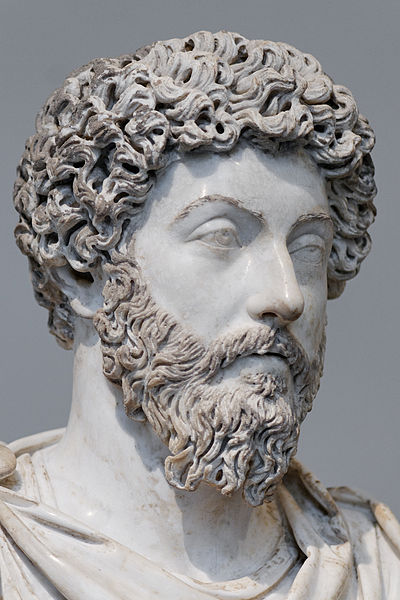
The best-kept secret of Stoic philosophy may be its intense and direct call to social action. As 21st-century Stoicism has burst onto the scene as a way of life that is alive and well, the old stereotype of the Stoic as a grimly detached, indifferent, and politically inactive personality is arguably falling apart.
Stoics, it turns out—real-life Stoics, with their blogs and podcasts and boisterous coffee shop gatherings—are very interested in action. Moral action, social action, creative action, philanthropic action, political action—these turn out to be not just compatible with, but essential to a genuinely Stoic life.
Through a series of events worthy of a Jurassic Park film, this largely extinct Greco-Roman philosophy has recently undergone a remarkable revival. For the first time in centuries, large numbers of people have been dusting off the classics and attempting to follow the demanding way of life described by the likes of Marcus Aurelius, Epictetus, and Seneca. It is now possible to learn and practice classical philosophy as part of a wider community, either online or through local organizations like the Stoic Fellowship, and with the help of extensive resources offered by various book authors and non-profit groups, such as Modern Stoicism.
People are attracted to Stoicism in a number of ways and for many different reasons. One of its chief strengths, though, is that Stoicism offers an integrated philosophy of life—a framework for making sense of not just one small part of our lives, but of the entire project of living well.
This framework has many components, including a rich tradition of mindfulness practice, therapeutic exercises, and rational spirituality. But one of the chief ways that Stoicism is expressed is through action—specifically action aimed at benefiting our fellow human beings. The basic commitments of the Stoic “Discipline of Action” are neatly expressed by the Roman statesman Seneca, who writes (in On Leisure, 1.4) that
we shall remain in active service right up to the very end of life, without ceasing to apply ourselves to the common good, to help the individual, and to give assistance with an aged hand even to our enemies. We Stoics are the ones who grant no exemptions from service at any age, and as that most eloquent of poets puts it, “We clamp down the war-helmet on our gray hair.” We are the ones who hold so strongly that there is no inactive moment before death that, if circumstance allows, death itself is not inactive.
In their day, the Stoics were famous for this active and service-oriented lifestyle. But today the tradition of socially engaged Stoicism has largely been forgotten. In most modern European languages, we think of the term “stoic” and its cognates as denoting a rather passive and amoral person—obsessed with eliminating uncomfortable emotions, and indifferent toward the events around them. Even among scholars, there has often been “no cliché more firmly anchored, and more difficult to uproot than the idea that ancient philosophy was an escape mechanism, an act of falling back upon oneself.”1
This is not how modern practitioners of Stoic philosophy experience their tradition. We think it is high time to bring the Discipline of Action back into fashion.
A Life of Action
Toward that end, over the past two years we have been hosting conversations on Stoic social action in the Stoics for Justice Facebook group, and collecting a bibliography of papers and essays that illustrate the modern Stoic movement’s developing engagement with social matters at several levels. We have organized these discussions into a scheme that combines inspiration from an ancient Stoic form of compassion meditation (known as the Circles of Hierocles) with the kinds of social roles that these spheres of concern may entail (an approach known as role ethics, emphasized by Epictetus):

We believe that this framework helps to express the way that classical philosophy calls us to a tightly integrated and consistent view of our highest driving goals. Modern thinkers have often observed that today’s thriving secular democracies have a tendency to push us toward a fragmented view of ourselves: questions about our deepest values and aims tend to get set aside in favor of easier and less controversial projects—like the pursuit of economic productivity.2 This environment makes it something of an uphill battle if we wish to define and cultivate a holistic philosophy of life for ourselves. “Our culture doesn’t encourage people to think about such things,” writes modern Stoic philosopher William Irvine; “indeed, it provides them with an endless stream of distractions so they won’t ever have to”.3
In part because of the way that it encourages us to actively think about the full sweep of our values and our public and private roles—and to make kindness and affection for others a guiding marker for our lives—Stoicism is well-positioned to step into this gap left open by modern culture. As Alasdair MacIntyre puts it in After Virtue—one of the great 20th-century texts that has helped to revive the notion of (classical) philosophy as a way of life—
I am brother, cousin and grandson, member of this household, that village, this tribe. These are not characteristics that belong to human beings accidentally, to be stripped away in order to discover ‘the real me.’ They are part of my substance, defining partially at least and sometimes wholly my obligations and my duties.4
As a system of virtue ethics, Stoicism takes a flexible approach to defining right and wrong, requiring us to think about every situation for ourselves. Stoics often disagree with each other about important social and political questions—and that is to be expected! But for many contemporary followers of Greco-Roman ethics, this classical idea that we are “born to give and receive assistance” (On Anger, 1.5.2), that we “have come into being to work together, like feet, hands, eyelids, or the two rows of teeth in our upper and lower jaws” (Meditations, 2.1) , and that we are “citizens of the world” is what literally gets us out of bed in the morning (Meditations, 5.1):
Early in the morning, when you find it so hard to rouse yourself from your sleep, have these thoughts ready at hand: ‘I am rising to do the work of a human being.’
This basic call to pro-social action (which is always aspirational—we are none of us Sages!) takes individual Stoics in a slew of different directions, depending on the roles that they have chosen to invest in. These include anything from a focus on being a good friend and professional all the way up to running for political office or engaging in activist protests.
With all this in mind, we are pleased to launch Stoics in Action as a new platform for promoting and developing socially engaged Stoicism as a vibrant way of life. We have three basic aims:
-
To show the world by example that—contrary to popular belief—Stoicism is an active, affectionate, philanthropic, and politically engaged way of life.
-
To provide a forum for contemporary Stoics to develop and refine their approach to social life in six key domains: family and friends, career, service and philanthropy, politics, the environment, and intersectional identities.
-
To provide a nexus for Stoics to organize joint philanthropic projects, and/or to share tips and resources on how to get involved with service.
If you’re ready to see where these ideas might take us, I invite you to continue reading with A Snapshot of Stoic Action Today.
References
[1] Pierre Hadot (1995), Philosophy as a Way of Life. Malden, MA: Blackwell Publishing, p. 274.
[2] Alasdair MacIntyre (2007), After Virtue (3rd ed.). Notre Dame, Indiana: University of Notre Dame Press, p. 30.
[3] William Irvine (2009), A Guide to the Good Life: The Ancient Art of Stoic Joy. Oxford: Oxford University Press, p. 1.
[4] MacIntyre, p. 33.

